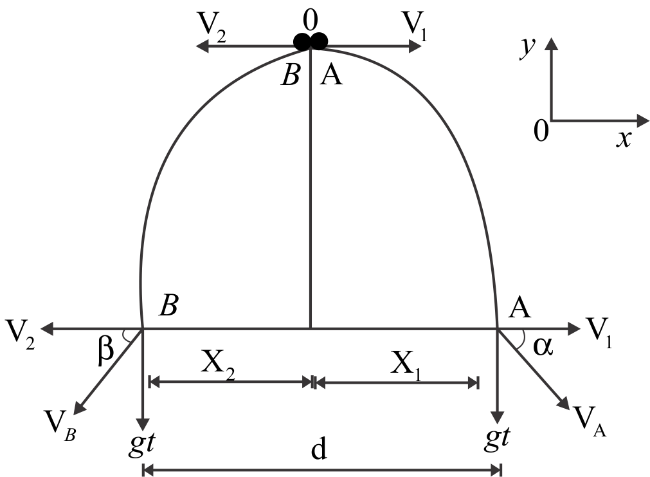Question
Question: Two balls are thrown horizontally from the top of a tower with velocities \({V_1}\) and \[{V_2}\] in...
Two balls are thrown horizontally from the top of a tower with velocities V1 and V2 in opposite directions at the same time. After how much time the angle between the velocities of balls becomes 90∘?
(A) g2V1V2
(B) gV1V2
(C) V1V2g
(D) 2gV1V2g
Solution
When a particle is projected obliquely close to the earth’s surface, it moves at the same time within the direction of horizontal and vertical. The motion of such a particle is termed Projectile Motion. Here we will use the concept of the projectile and solve the question.
<>Formula used:**
Velocity,
⇒V=gt; Where V is the velocity, g is the acceleration due to gravity, and t is the time.
Complete Step By Step Solution:

At the instant velocities of A and B which is being perpendicular to each other, suppose they make an angle of β and α with the horizontal and the separation between them will be X1+X2.
Since each of the balls is thrown horizontally, each is acted upon a similar acceleration of gravity g
And they will be having constant velocities in the vertical direction which is V=gt. Since there's no horizontal acceleration acting upon the balls the horizontal velocities of A and B are constant as initial, that is, V1 and V2 respectively.
After the time t,
The velocity of A will be,
⇒VA=V1i∧−gtj∧
The velocity of B will be,
⇒VB=V2i∧−gtj∧
Since VA⊥VB
So the dot product of the vector will be
⇒VA.VB=0
On solving the dot product of the above vector equation, we get
⇒−V1V2+g2t2=0
⇒t=gV1V2
Joining each of the vector triangles we tend to must get a triangle as A and B are perpendicular to each other at the moment.
⇒α+β=90∘
Angle for α will be
⇒tanα=V1gt
Angle for β will be
⇒tanβ=V2gt
From the formula
⇒tanαtanβ=tanαtan(90∘−α)=1
Putting the values of both the angles,
⇒V1gt.V2gt=1
We get,
⇒t=gV1V2
Therefore in gV1V2 time, the angle between velocities of balls becomes90∘.
Note: Horizontal component of initial speed is ucosθ. The initial speed in the vertical component will be usinθ. The horizontal component of speed ucosθ remains the same throughout the entire journey as no acceleration is acting horizontally. The vertical component of speed usinθ decreases step by step and becomes zero at the highest purpose of the path. At the highest purpose, the speed of the body is ucosθ in the horizontal direction and therefore the angle between the speed and acceleration is 90∘.
